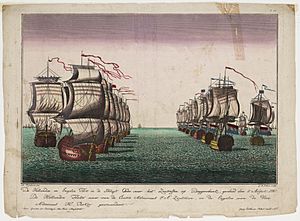HMS Fortitude (1780) facts for kids

Fortitude
|
|
Quick facts for kids History |
|
|---|---|
| Name | HMS Fortitude |
| Ordered | 2 February 1778 |
| Builder | Randall, Rotherhithe |
| Laid down | 4 March 1778 |
| Launched | 23 March 1780 |
| Honours and awards |
|
| Fate | Broken up, 1820 |
| General characteristics | |
| Class and type | Albion-class ship of the line |
| Tons burthen | 1645 bm |
| Length | 168 ft (51 m) (gundeck) |
| Depth of hold | 18 ft 10 in (5.74 m) |
| Propulsion | Sails |
| Sail plan | Full-rigged ship |
| Armament |
|
HMS Fortitude was a large warship with 74 guns. It was known as a "ship of the line" because it fought in a line formation during battles. This ship was built for the British Royal Navy and was launched on March 23, 1780.
Under Captain Richard Bickerton, Fortitude sailed in the English Channel. In April 1781, it helped deliver supplies to Gibraltar during a siege. Later that year, during a war with the Dutch, a top admiral, Hyde Parker, made Fortitude his main ship. On August 5, Fortitude fought in the Battle of Dogger Bank. It was a tough fight, and neither side won a clear victory.
Contents
Fortitude in the French Revolutionary Wars
In 1793, Captain William Young took command of Fortitude. The ship sailed to the Mediterranean Sea to join Admiral Sir Samuel Hood's fleet.
Attack on Mortella Point
On February 7, 1794, Fortitude and another ship, Juno, attacked a tower. This tower was at Mortella Point, on the coast of Corsica. The tower had only 33 defenders.
Even though the ships fired many guns, the tower held out for two days. It finally surrendered to soldiers on land. Fortitude was badly damaged during the attack. Its hull, masts, and sails were hit, especially by hot cannonballs. Six of its crew members were killed, and 56 were wounded. The British were so impressed by the tower's design. They later used it as a model for their own Martello Towers in Britain and other places.
Battles off Genoa and Hyères
Under Captain Thomas Taylor, Fortitude took part in battles near Genoa on March 13, 1795. It also fought near Hyères on July 13, 1795. The battle near Genoa led to the British fleet chasing the French fleet. The British captured two French ships. The battle near Hyères was also not a clear win for either side. However, the British did capture one French ship.
Convoy Duty and Capture of Censeur
On September 25, 1795, Fortitude began sailing back to Britain. It was protecting a large group of merchant ships, called a convoy. On October 7, 1795, the convoy saw a large French fleet near Cape St. Vincent. The French ships started to chase them.
One of the captured French ships, Censeur, was with the convoy. It had lost a mast and was not ready for battle. The French fleet then recaptured Censeur. They also captured 30 other ships from the convoy. The remaining ships continued their journey to England.
Later Years and Fate
From 1795, Fortitude was used as a prison ship. This meant it held prisoners on board. From 1802, it became a "powder hulk" at Portsmouth. A powder hulk was a ship used to store gunpowder safely. Fortitude was finally taken apart in 1820.


